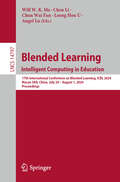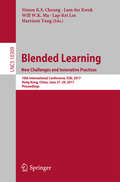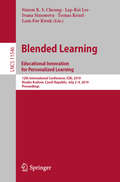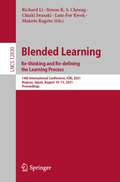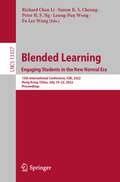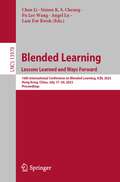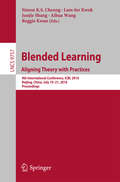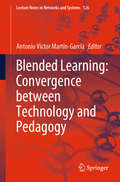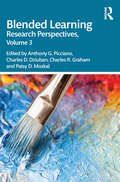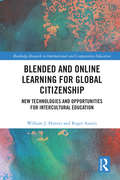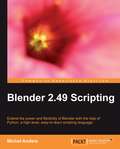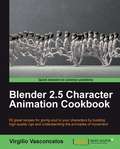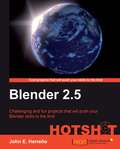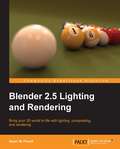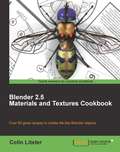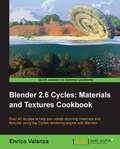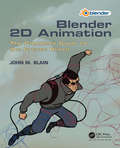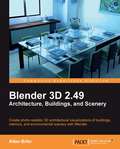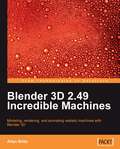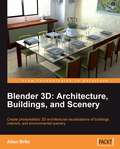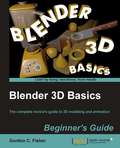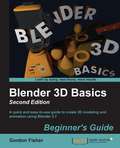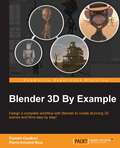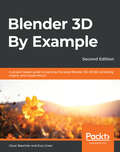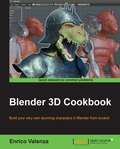- Table View
- List View
Blended Learning. Intelligent Computing in Education: 17th International Conference on Blended Learning, ICBL 2024, Macao SAR, China, July 29 – August 1, 2024, Proceedings (Lecture Notes in Computer Science #14797)
by Will W. K. Ma Leong Hou U Chen Li Angel Lu Chun Wai FanThis book constitutes the refereed proceedings of the 17th International Conference on Blended Learning. Intelligent Computing in Education, ICBL 2024, held in Macao, China, during July 29 - August 1, 2024. The 26 papers presented in this volume were carefully reviewed and selected from 71 submissions. The selected papers are classified into four primary themes: revolutionizing education with AI; blended learning and technological innovations; advancements in learning analytics; and innovative approaches in educational research.
Blended Learning. New Challenges and Innovative Practices: 10th International Conference, ICBL 2017, Hong Kong, China, June 27-29, 2017, Proceedings (Lecture Notes in Computer Science #10309)
by Will W.K. Ma Simon K.S. Cheung Lam-For Kwok Harrison Yang Lap-Kei LeeThis book constitutes the refereed proceedings of the 10th International Conference on Blended Learning, ICBL 2017, held in Hong Kong, China, in June 2017. The 42 papers presented were carefully reviewed and selected from 100 submissions. The papers are organized in topical sections named: Keynotes; Experiences in Blended Learning; Strategies in Blended Learning; Assessment for Blended Learning; Computer-Support Collaborative Learning; Improved Flexibility of Learning Processes; Open Educational Resources; Pedagogical and Psychological Issues.
Blended Learning: 12th International Conference, ICBL 2019, Hradec Kralove, Czech Republic, July 2–4, 2019, Proceedings (Lecture Notes in Computer Science #11546)
by Lam-For Kwok Lap-Kei Lee Simon K. Cheung Ivana Simonova Tomas KozelThis book constitutes the refereed proceedings of the 12th International Conference on Blended Learning, ICBL 2019, held in Hradec Kralove, Czech Republic, in July 2019. The 28 papers presented were carefully reviewed and selected from 80 submissions. The papers are organized in topical sections named: personalized and adaptive learning; content development for blended learning; experience in blended learning; analytics and evaluation for blended learning; open educational resources; and pedagogical and psychological issues.
Blended Learning: 14th International Conference, ICBL 2021, Nagoya, Japan, August 10–13, 2021, Proceedings (Lecture Notes in Computer Science #12830)
by Lam-For Kwok Richard Li Simon K. S. Cheung Chiaki Iwasaki Makoto KagetoThis book constitutes the refereed proceedings of the 14th International Conference on Blended Learning, ICBL 2021, held online in August 2021. The 30 papers, including 4 keynote papers, were carefully reviewed and selected from 79 submissions. The conference theme of ICBL 2021 is Blended Learning: Re-thinking and Re-defining the Learning Process. The papers are organized in topical sections named: content and instructional design; enriched and smart learning experience; experience in blended learning; institutional policies and strategies; and online and collaborative learning.
Blended Learning: 15th International Conference, ICBL 2022, Hong Kong, China, July 19–22, 2022, Proceedings (Lecture Notes in Computer Science #13357)
by Fu Lee Wang Simon K. S. Cheung Richard Chen Li Peter H. F. Ng Leung-Pun WongThis book constitutes the refereed proceedings of the 15th International Conference on Blended Learning, ICBL 2022, held in Hong Kong, China, in August 2022. The 31 papers presented in this volume were carefully reviewed and selected from 80 submissions. The conference theme of ICBL 2022 is Blended Learning: Engaging Students in the New Era. The papers are organized in topical sections named: Game-based Learning and Augmented Learning Environment; Computer Supported Collaborative Learning; Enriching Learning Experience with Blended and Online Learning; Content Development and Practice for Blended Learning and Beyond.
Blended Learning: 16th International Conference on Blended Learning, ICBL 2023, Hong Kong, China, July 17-20, 2023, Proceedings (Lecture Notes in Computer Science #13978)
by Fu Lee Wang Chen Li Simon K. S. Cheung Lam For Kwok Angel LuThis book constitutes the refereed proceedings of the 16th International Conference on Blended Learning, ICBL 2023, held in Hong Kong, China, on July 17-20, 2023. The 24 papers presented in this volume were carefully reviewed and selected from 57 submissions. The papers are organized in topical sections named: smart classroom and digital literacy; online and distant learning; content and pedagogy development for blended learning; gamification and lnteractive learning snvironment; learning analytics and big data in education.
Blended Learning: 9th International Conference, ICBL 2016, Beijing, China, July 19-21, 2016, Proceedings (Lecture Notes in Computer Science #9757)
by Simon K.S. Cheung Lam-For Kwok Reggie Kwan Junjie Shang Aihua WangThis book constitutes the refereed proceedings of the 9th International Conference on Blended Learning, ICBL 2016, held in Beijing, China, in July 2016. The conference is formerly known as International Conference on Hybrid Learning (ICHL) The 34 papers presented were carefully reviewed and selected from 61 submissions. The selected papers cover various aspects on collaborative and interactive learning, content development, open and flexible learning, assessment and evaluation, pedagogical and psychological issues, experience in blended learning, and strategies and solutions.
Blended Learning: Convergence between Technology and Pedagogy (Lecture Notes in Networks and Systems #126)
by Antonio Víctor Martín-GarcíaThis book focuses on essential aspects of the theoretical foundations that support blended learning (BL) as a teaching training modality in tertiary education. Analyzing the changes in the world of education that lead to new ways of thinking and learning, it redefines the concept of blended learning at a time of constant growth in many universities around the world. This involves a shared reflection on the role of technology in the current university teacher education programs, as well as on the role that pedagogy plays in increasingly technology-driven contexts. Furthermore, the book presents pedagogical approaches to guide university professors in the design and implementation of blended learning courses. To this end, it describes some of the major models and approaches to BL instructional design, and examines issues related to the quality of BL training and the indicators to measure it, in order to identify those models that contribute to a better understanding of the dimensions that increase its effectiveness.
Blended Learning: Research Perspectives, Volume 3
by Charles R. Graham Anthony G. Picciano Charles D. Dziuban Patsy D. MoskalBlended Learning: Research Perspectives, Volume 3 offers new insights into the state of blended learning, an instructional modality that combines face-to-face and digitally mediated experiences. Education has recently seen remarkable advances in instructional technologies such as adaptive and personalized instruction, virtual learning environments, gaming, analytics, and big data software. This book examines how these and other evolving tools are fueling advances in our schools, colleges, and universities. Original scholarship from education’s top thinkers will prepare researchers and learning designers to tackle major issues relating to learning effectiveness, diversity, economies of scale, and beyond.
Blended and Online Learning for Global Citizenship: New Technologies and Opportunities for Intercultural Education (Routledge Research in International and Comparative Education)
by Roger Austin William J. HunterBy showcasing international, European, and community-based projects, this volume explores how online technologies and collaborative and blended learning can be used to bolster social cohesion and increase students’ understanding of what it means to be a global citizen. With the pace of technology rapidly increasing, Blended and Online Learning for Global Citizenship draws timely attention to the global lessons being learned from the impact of these technologies on peace building, community development, and acceptance of difference. In-depth case studies showcasing successful projects in Europe, Northern Ireland, and Israel explore blended learning and illustrate how schools and educators have embraced online technologies to foster national and international links both within and beyond communities. This has, in turn, equipped students with experiences that have informed their attitudes to cultural and political conflicts, as well as racial, ethnic, and social diversity. Building on the authors’ previous work Online Learning and Community Cohesion (2013), this thought-provoking text will be of interest to researchers, academics, and postgraduate students in the fields of international and comparative education. Educators and school leaders concerned with how multiculturalism and technology play out in the classroom environment will also benefit from reading this text.
Blender 2.49 Scripting
by Michel J. AndersThe focus of the book is on practical problems and how to solve them in Python. The examples given are useful programs that try to solve real-world needs. Each chapter revolves around a single concept giving several examples gradually growing in difficulty. Each section analyses the problem first before diving into coding and gives extensive background information to enable the reader to generalize from the specific problem to a wider range of challenges. The sample code is provided as fully working examples with all key issues extensively highlighted. All sample programs are clear and concise yet nothing essential is left out and the programming style focuses on readability rather than on stylistic rigor or efficiency. This book is for users comfortable with Blender as a modeling and rendering tool who want to expand their skills to include Blender scripting to automate laborious tasks and achieve results otherwise impossible. Blender experience is essential as is some experience in Python programming.
Blender 2.5 Character Animation Cookbook
by Virgilio VasconcelosThe book is a practical guide explaining the various features of the NetBeans IDE related to enterprise application development.The book is aimed at Java developers who wish to develop Java EE applications while taking advantage of NetBeans functionality to automate repetitive tasks and to ease their software development efforts. Familiarity with NetBeans or Java EE is not assumed.
Blender 2.5 HOTSHOT
by John E. HerreñoUsing a projects based approach you will learn fun and challenging aspects of Blender 3D development. With each project you will be able to show off a creation that utilizes Blender 3D maximum potential.If you are already able to perform some basic tasks with Blender 3D and want to go from the simple and boring renders of monkey-headed characters living in box-like scenes to creating more detailed, visually richer, and more polished results then this book is for you. It will give you a good idea of the amount of complexity required for real-world projects and help you in deciding what area you are going to specialize in later on.This book is also useful if you are a user of any other 3D package wanting to get up and running fast with Blender 3D.
Blender 2.5 Lighting and Rendering
by Aaron W. PowellEach chapter develops a different aspect of a Blender technique. The book is essentially a step-by-step tutorial, which builds up your knowledge throughout. It has practical examples such as lighting a tricycle in open space, lighting a wine bottle on a table, and lighting a room that has a lamp as well as sunlight coming in through the window. These examples will show you how to implement the different Blender techniques in your work.If you are a Blender user and you want to improve the quality of your renders, this book is for you. You need to have experience in Blender and know your way around the Blender interface. You may be a professional or freelancer or hobbyist willing to increase the quality of your portfolio and interested in adding perfection to your renders.
Blender 2.5 Materials and Textures Cookbook
by Colin LitsterEach chapter in the book follows a themed approach to creating materials using the new Blender 2.5 features. As you read through each chapter you will learn approaches to create materials and textures. These materials and textures will help you to create a flawless simulation of real-world objects. You need not read the chapters in any particular order to learn to use the Blender 3D suite for materials simulation appropriately. Every recipe in this book will enable you to create a usable material or texture effect as well as teaching you techniques that save your time. If you are a Graphics Designer looking to master the features for materials and textures to create realistic looking models in Blender, then this book is for you. It can be read by both beginners and experienced Blender users; however, prior understanding of object creation and manipulation in Blender would be an advantage. This is a must-read for Blender users who want to learn the concepts and at the same time experiment with the different Blender Material and texture functions.
Blender 2.6 Cycles:Materials and Textures Cookbook
by Enrico ValenzaWritten in a friendly, practical style this Cookbook deep-dives into a wide-array of techniques used to create realistic materials and textures.This book is perfect for you if you have used Blender before but are new to the impressive Cycles renderer. You should have some knowledge of the Blender interface, though this is not a strict requirement. If you want to create realistic, stunning materials and textures using Cycles, then this book is for you!
Blender 2D Animation: The Complete Guide to the Grease Pencil
by John M. BlainThis book describes how to access the Grease Pencil component in Blender and create 2D Animation within the Blender 3D environment. It is assumed that the reader has no previous knowledge of the Blender program and treats 2D Animation using the Grease Pencil as a standalone application.Grease Pencil is a component of the 3D modeling and animation program, Blender. Blender is a free open-source 3D Computer Graphics software toolset used for creating animated films, visual effects, art, 3D printed models, motion graphics, interactive 3D applications, virtual reality and computer games.Key Features: The first comprehensive beginner's guide to the Grease Pencil component of Blender Facets of operation are explained in short concise chapters with cross references Written instruction is accompanied by diagram illustrations in reference to the program's Graphical User Interface The book is also available in a discounted set along with The Complete Guide to Blender Graphics: Computer Modeling & Animation.
Blender 3D 2.49 Architecture, Buidlings, and Scenery
by Allan BritoThe book consists of a lot of exciting examples, which are shaped using the various features of Blender. It provides step-by-step instructions leading you to realistic models of buildings, landscapes, and more. A collection of amazing screenshots will add excitement to your learning experience. You can build realistic 3D models that can be used while creating different animation projects.The printed version of the book is in black and white, but a full color version of the images is available for download here. The eBook version, available from Packt, is in full color. This book is for architects, game designers, artists, or movie makers who want to create realistic buildings, interiors, and scenery using Blender 3D, a free, open-source graphics tool. This book is not a general introduction to Blender, but focuses on developing expertise on the architectural aspects of the tool. You need not have prior knowledge of Blender.
Blender 3D 2.49 Incredible Machines
by Allan BritoThis book presents practical tutorials and focuses on fun projects. It contains a lot of serious training material, but is presented in a fun and entertaining way. This book targets game designers/developers, artists, and product designers who want to create realistic images, 3D models, and videos of machines. You are expected to have experience with basic Blender operation, as the book is not a 'getting started' tutorial.
Blender 3D Architecture, Buildings, and Scenery
by Allan BritoThe book consists of a lot of exciting examples, which are shaped using the various features of Blender. It consists of step-by-step instructions leading you to realistic models of buildings, landscapes, and more. A collection of amazing screenshots will add up excitement to your learning experience. You can build realistic 3D models that can be used while creating different animation projects. The printed version of the book is in black and white, but a full color version of the images is available for download here. The eBook version, available from Packt, is in full color.This book is for architects, game designers, artists, or movie makers who want to create realistic buildings, interiors, and scenery using Blender 3D, a free, open-source graphics tool. This book is not a general introduction to Blender, but focuses on developing expertise on the architectural aspects of the tool. Readers need not have prior knowledge of Blender.
Blender 3D Basics
by Gordon FisherWritten in a step by step tutorial style, learning comes as a result of creating the fully animated scene and the explanations that follow each stage. Blender 3D Basics is great for anyone who is new to Blender or new to 3D.
Blender 3D Basics: Second Edition
by Gordon FisherThis book is for 3D Artists and Designers who want to learn efficient building of 3D Animations. Knowledge of 3D Modeling is essential but no prior experience with Blender is required.
Blender 3D By Example
by Romain Caudron Pierre-Armand NicqDesign a complete workflow with Blender to create stunning 3D scenes and films step-by-step! About This Book * Give life to a character within a full animated short film by learning the rigging and animation process * Make use of the powerful tools available in Blender to produce professional-quality 3D characters and environments * Discover advanced techniques by adding fur to a character, creating a grass field, and fine-tuning a shot with post-processing effects to enhance your creations Who This Book Is For This book will give any beginner the necessary skills and knowledge to create own 3D projects with Blender. You don't need to have any previous experience in 3D modeling, but if you do, then this book is a great way get you started with Blender. This book is for anyone who wants to learn Blender by creating concrete projects. What You Will Learn * Understand the basics of 3D and how to navigate your way around the Blender interface * Create a 3D robot toy model from start to finish using the basic modeling tools of Blender * Make a full alien character using the skin mesh modifier and the sculpting tools with an artistic approach * Use re-topology techniques to create a clean 3D version of the previously sculpted alien * Model a full haunted house and its environment using more advanced modeling tools and techniques such as the Array Modifier, Instance duplication, or Curves * Discover the power of the texture paint tool in order to add color to the haunted house * Get to know the Cycles render engine by creating different materials for the house and the environment In Detail Blender is a powerful tool, stable, with an integral workflow that will allow you to understand your learning of 3D creation with serenity. Today, it is considered to be one of the most complete 3D packages on the market and it is free and open source! It is very efficient for many types of productions, such as 3D animated or live action films, architecture, research, or even game creation with its integrated game engine and its use of the Python language. Moreover, Blender has an active community that contributes to expanding its functionalities. Today, it is used in many professional products and by many companies. Through this book, you will create many types of concert projects using a step-by-step approach. You will start by getting to know the modeling tools available in Blender as you create a 3D robot toy. Then, you will discover more advanced techniques such as sculpting and re-topology by creating a funny alien character. After that, you will create a full haunted house scene. For the last project, you will create a short film featuring a rat cowboy shooting cheese in a rat trap! This will be a more complex project in which you learn how to rig, animate, compose advanced material, composite, and edit a full sequence. Each project in this book will give you more practice and increase your knowledge of the Blender tools. By the end of this book, you will master a workflow that you will be able to apply to your own creations. Style and approach This is an easy-to-follow book that is based on four concrete projects, with increasing levels of difficulty. Each chapter will teach you how to create these projects step-by-step. New tools and techniques are introduced in a theoretical and practical way, so you can apply them in your own projects later.
Blender 3D By Example: A project-based guide to learning the latest Blender 3D, EEVEE rendering engine, and Grease Pencil, 2nd Edition
by Oscar Baechler Xury GreerGet up and running with Blender 3D through a series of practical projects that will help you learn core concepts of 3D design like modeling, sculpting, materials, textures, lighting, and rigging using the latest features of Blender 2.83 Key Features Learn the basics of 3D design and navigate your way around the Blender interface Understand how 3D components work and how to create 3D content for your games Familiarize yourself with 3D Modeling, Texturing, Lighting, Rendering and Sculpting with Blender Book Description Blender is a powerful 3D creation package that supports every aspect of the 3D pipeline. With this book, you'll learn about modeling, rigging, animation, rendering, and much more with the help of some interesting projects. This practical guide, based on the Blender 2.83 LTS version, starts by helping you brush up on your basic Blender skills and getting you acquainted with the software toolset. You'll use basic modeling tools to understand the simplest 3D workflow by customizing a Viking themed scene. You'll get a chance to see the 3D modeling process from start to finish by building a time machine based on provided concept art. You will design your first 2D character while exploring the capabilities of the new Grease Pencil tools. The book then guides you in creating a sleek modern kitchen scene using EEVEE, Blender's new state-of-the-art rendering engine. As you advance, you'll explore a variety of 3D design techniques, such as sculpting, retopologizing, unwrapping, baking, painting, rigging, and animating to bring a baby dragon to life. By the end of this book, you'll have learned how to work with Blender to create impressive computer graphics, art, design, and architecture, and you'll be able to use robust Blender tools for your design projects and video games. What you will learn Explore core 3D modeling tools in Blender such as extrude, bevel, and loop cut Understand Blender's Outliner hierarchy, collections, and modifiers Find solutions to common problems in modeling 3D characters and designs Implement lighting and probes to liven up an architectural scene using EEVEE Produce a final rendered image complete with lighting and post-processing effects Learn character concept art workflows and how to use the basics of Grease Pencil Learn how to use Blender's built-in texture painting tools Who this book is for Whether you're completely new to Blender, or an animation veteran enticed by Blender's newest features, this book will have something for you.
Blender 3D Cookbook
by Enrico ValenzaThis book is aimed at the professionals that already have good 3D CGI experience with commercial packages and have now decided to try the open source Blender and want to experiment with something more complex than the average tutorials on the web.<P><P> However, it's also aimed at the intermediate Blender users who simply want to go some steps further. It's taken for granted that you already know how to move inside the Blender interface, that you already have 3D modeling knowledge, and also that of basic 3D modeling and rendering concepts, for example, edge-loops, n-gons, or samples. In any case, it's also possible for a keen beginner to follow this book, by combining it with the manual on the BlenderWiki or preceding it with a basic Blender UI tutorial on the web.<P> The keyboard/mouse shortcuts for the operations in the recipes are, at least in all the more relevant cases, indicated in brackets.
